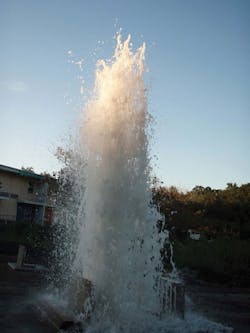Up in the Air
Geysering—the eruption of a water column into the atmosphere—is caused by air that has been trapped and compressed in cavities within an aquifer. Geysers were observed in a few Orange County, Fla., drainage wells in the mid- to late 2000s.
Drainage wells are vertical wells drilled into the earth to drain water into the underground aquifer. These wells historically have been used for storm water management and flood control by controlling the water levels of lakes, recharging the aquifer, and alleviating street flooding in areas lacking adequate storm sewer systems, such as closed drainage basins. Water flowing into the drainage well takes the path of least resistance. At lower flow rates, water flows over the top of the well casing and trickles down the casing walls. However, as the height of the water above the well’s top of casing increases during a storm event, the flow rate increases and causes changes in the flow regime from laminar to turbulent. At higher rates of discharge, the water takes a spiral path and the velocity increases as flow tends inward to the center to form a vortex. When a vortex occurs, air is entrained within the water and dragged down into the aquifer.
The Geysering Problem
Geysering drainage wells in Orange County are of particular concern because these wells usually are in urban settings where the violent discharge of water can become a threat to public health, safety and welfare. In addition, if there is flooding and the well is geysering, it cannot be cleaned out on an emergency basis, due to the danger posed to the crew in its proximity. Moreover, geysering also can result in scouring at the bottom of the well casing, which creates potential for
a sinkhole.
Many field attempts have been made to correct the geysering problems in drainage wells, including:
- Installing an inverted J-shaped pipe attached to the top of the well casing to create a siphoning affect;
- Installing a secondary well near the drainage well to serve as a venting well for the entrapped air;
- Extending the open borehole interval to increase the contact with cavities, which is thought to help buffer downhole pressure changes; and
- Modifying the inflow structure to reduce flow and prevent an oscillating flow regime.
Because the key to preventing geysering is to stop or minimize the formation of trapped air within the well column or in cavities within the aquifer, one successful approach in past Orange County projects has been to install a notched coupling at the top of the well casing to reduce the discharge and minimize the amount of air being sucked down into the well. The coupling is notched over part of the perimeter and acts as a weir. Flow only enters the well through the notched portion of the coupling, and its size can be adjusted based on actual trials. This measure successfully eliminated geysering at drainage wells in Lake Holden and Keystone Drive, both located in Orlando, Fla., and allowed acceptable levels of discharge.
The Wells
The existing Keystone Drive drainage well was replaced with one 12-in.-diameter, 303-ft-deep well. Several days after completion, the well was observed to geyser. In an effort to address the geysering, approval from the permitting agencies was obtained to extend the open borehole to 400 ft. Geysering still occurred, however. In order to eliminate it, a section of PVC pipe with a rectangular orifice was fitted to the top of the well casing to limit the flow entering the wellhead and prevent air entrapment within the formation. Seven years have passed since the installation of the weir coupling, and no geysering has been observed.
On the other hand, the existing Lake Holden drainage well was replaced with a straight-line array of three drainage wells: two 12-in.-diameter wells and one 6-in.-diameter well, equivalent in borehole area to the single 18-in.-diameter well that was replaced.
Each well was originally planned to be drilled to a depth of 450 ft below land surface, but a high water transmission cavity system in the aquifer that yielded flowing sand during drilling of the borehole limited their final depth. All three drainage wells eventually were completed within the depth range of 177 to 193 ft below land surface. Following the construction, load testing of each drainage well with pumped inflow from the lake disclosed very high recharge capacity without geysering.
After two weeks of continuous flow, however, the 12-in. central well started geysering. The observed flow and discharge rates were estimated to be in the range of 6,000 to 7,000 gal per minute. As time progressed, the central well geysering became so pronounced that the well was sealed off with a sleeve until a feasible solution could be found.
Various trial-and-error scenarios were evaluated to determine a sustainable solution, including sleeving the 12-in. central well while allowing full flow to the outer 6- and 12-in. wells; testing combinations of the two 12-in. wells flowing at full flow and letting the 6-in. well act as a vent; and equipping the two 12-in. wells with weir couplings while keeping the 6-in. well open to full flow. The successful scenario resulted from equipping both 12-in.-diameter wells with weir couplings with orifices of 4 by 6 in. (24 sq in.) and 4 by 14 in. (56 sq in.) respectively, and leaving the 6-in. well open to full flow. There was no geysering under these maximum flow conditions.
The replacement drainage well with slots in the two 12-in. wells has been effective in controlling geysering and provides a discharge capacity that is much higher in rate and is applicable over a broader range of lake levels compared with the original existing well.
Central Florida’s Challenges
The geysering phenomenon in the few Central Florida drainage wells is unique for each well and not readily understood because it involves a complex dynamic:
- Surface water flows into an orifice opening in the horizontal plane (top of the well casing) and resulting air entrapment in the injectate due to oscillating flow regime (submerged orifice flow/unsubmerged weir flow);
- Large pockets of entrapped air and gas, which exist in cavities of the aquifer formation (sometimes created by decaying organic debris, citrus waste and air columns from the injectate stream);
- Driving head in the injectate, which may reach a certain pressure threshold that causes the air pressure to reach a critical level and create a reverse pressure surge (e.g., head pressure when the lake level exceeds a certain critical elevation); and
- Borehole length and aquifer transmissivity and cavity ratio characteristics that are not totally understood.
Although it is difficult to identify the root cause(s) of geysering of any particular drainage well due to the multitude of potential factors that come into play, the installation of a notched coupling at the top of the well casing to reduce the discharge and minimize the amount of air being sucked down into the well has been a successful approach to minimize geysering in drainage wells.
Download: Here


